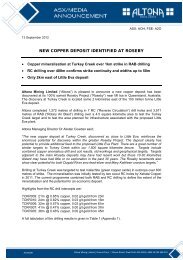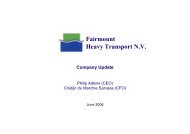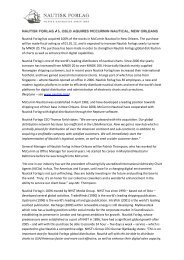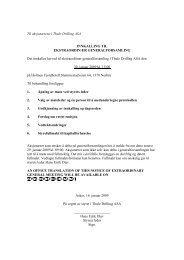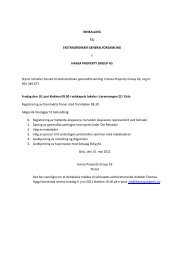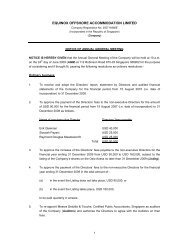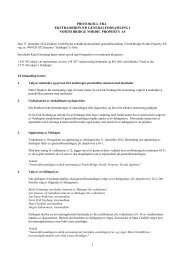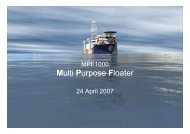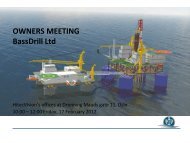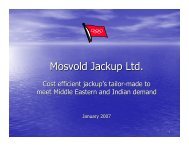You also want an ePaper? Increase the reach of your titles
YUMPU automatically turns print PDFs into web optimized ePapers that Google loves.
Notes – Marine Subsea Consolidated<br />
liabilities and their carrying amounts in the consolidated financial statements.<br />
However, the deferred income tax is not accounted for if it arises<br />
from initial recognition of an asset or liability in a transaction other<br />
than a business combination that at the time of the transaction affects<br />
neither accounting nor taxable profit or loss. Deferred income tax is determined<br />
using tax rates (and laws) that have been enacted or substantially<br />
enacted by the balance sheet date and are expected to apply when<br />
the related deferred income tax asset is realised or the deferred income<br />
tax liability is settled.<br />
Deferred income tax assets are recognised to the extent that it is<br />
probable that future taxable profit will be available against which the<br />
temporary differences can be utilised.<br />
Deferred income tax is provided on temporary differences arising on<br />
investments in subsidiaries and joint ventures, except where the timing<br />
of the reversal of the temporary difference is controlled by the group<br />
and it is probable that the temporary difference will not reverse in the<br />
foreseeable future.<br />
2.16 Employee benefits<br />
(a) Pension obligations<br />
One of the Group companies operates on a pension scheme. The<br />
scheme is generally funded through payments to insurance companies<br />
or trustee-administered funds, determined by periodic actuarial<br />
calculations. The scheme is a defined benefit plan. A defined benefit<br />
plan is a pension plan that is not a defined contribution plan. Typically,<br />
defined benefit plans define an amount of pension benefit that an<br />
employee will receive on retirement, usually dependent on one or more<br />
factors such as age, years of service and compensation.<br />
The liability recognised in the balance sheet in respect of defined benefit<br />
pension plans is the present value of the defined benefit obligation at<br />
the balance sheet date less the fair value of plan assets, together with<br />
adjustments for unrecognised actuarial gains or losses and past service<br />
costs. The defined benefit obligation is calculated annually by independent<br />
actuaries using the projected unit credit method. The present value<br />
of the defined benefit obligation is determined by discounting the<br />
estimated future cash outflows using interest rates of high-quality corporate<br />
bonds that are denominated in the currency in which the benefits<br />
will be paid and that have terms to maturity approximating to the terms<br />
of the related pension liability.<br />
Actuarial gains and losses arising from experience adjustments and<br />
changes in actuarial assumptions in excess of the greater of 10% of the<br />
value of plan assets or 10% of the defined benefit obligation are charged<br />
or credited to income over the employees’ expected average remaining<br />
working lives.<br />
(b) Share-based compensation<br />
The group operated an equity-settled, share-based compensation plan<br />
for one of the Group’s financial advisor. The fair value of these services<br />
and employee services received in exchange for the grant of the options<br />
is recognised as an expense. The total amount to be expensed over the<br />
vesting period is determined by reference to the fair value of the options<br />
granted. At each balance sheet date, the entity revises its estimates<br />
of the number of options that are expected to vest. It recognises the<br />
impact of the revision to original estimates, if any, in the income statement,<br />
with a corresponding adjustment to equity. The option forefeited<br />
in August 2009.<br />
(c) Profit-sharing and bonus plans<br />
The group recognises a liability and an expense for bonuses and profitsharing,<br />
based on a formula that takes into consideration the profit<br />
attributable to the company’s shareholders after certain adjustments.<br />
The group recognises a provision where contractually obliged or where<br />
there is a past practice that has created a constructive obligation.<br />
2.17 Provisions<br />
Provisions for legal claims and other are recognised when: the group<br />
has a present legal or constructive obligation as a result of past events;<br />
it is probable that an outflow of resources will be required to settle the<br />
obligation; and the amount has been reliably estimated.<br />
2.18 Revenue recognition<br />
Revenue comprises the fair value of the consideration received or<br />
receivable for the sale of goods and services in the ordinary course of<br />
the group’s activities. Revenue is shown net of value-added tax, returns,<br />
rebates and discounts and after eliminating sales within the group.<br />
The group recognises revenue when the amount of revenue can be<br />
reliably measured, it is probable that future economic benefits will flow<br />
to the entity and when specific criteria have been met for each of the<br />
group’s activities as described below. The amount of revenue is not<br />
considered to be reliably measurable until all contingencies relating to<br />
the sale have been resolved. The group bases its estimates on historical<br />
results, taking into consideration the type of customer, the type of<br />
transaction and the specifics of each arrangement.<br />
(a) Time Charter revenues<br />
Time charter revenues are recorded over the term of the charter as a<br />
service is provided and when the general revenue recognition criteria<br />
described above have been fulfilled. The fair value of the lease element<br />
of the contract is recognised on a straight line basis over the lease term.<br />
Certain contracts include mobilisation fees payable at the start of the<br />
contract. In cases where the fee covers specific upgrades or equipment<br />
specific to the contract, the mobilisation fees are recognised as revenue<br />
over the estimated life of the customer contract period. The related<br />
investment is depreciated over the estimated useful life of the contract<br />
period. The fair value of the service element of the contract is recognised<br />
at the time the service has been rendered.<br />
(b) Bareboat Charter revenues<br />
The lease element of the contract is recognised on a straight line basis<br />
over the lease term.<br />
2.19 Leases<br />
Leases in which a significant portion of the risks and rewards of ownership<br />
are retained by the lessor are classified as operating leases. Payments<br />
made under operating leases (net of any incentives received from<br />
<strong>Annual</strong> <strong>Report</strong> 2009 Marine Subsea 29




